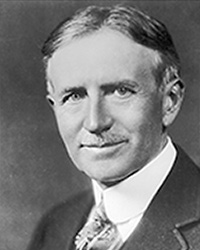
Firestone Tire & Rubber Company Founder Harvey Firestone
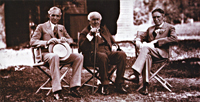
Lifelong friends, Harvey S. Firestone (right), founder of The Firestone Tire & Rubber Company, Thomas Edison (center) and Henry Ford (left)
On August 3, 1900, the Firestone Tire & Rubber Company was founded in Akron, Ohio. In those initial days, they introduced the solid rubber sidewire tire as one of the first Firestone products. On December 27, Harvey S. Firestone Jr. was lifted into the air to pull the engine switch that put the first Firestone factory in operation. Firestone began manufacturing its own tires for the first time in 1903, and by late summer of the next year, they’d developed the first mechanically-fastened, straight-sided pneumatic automobile tire. In 1906, Firestone delivered 2,000 sets of tires to the Ford Motor Company. It was the largest single order for tires places by the auto industry to date, and would start a business partnership that would last for decades. A few years later in 1909, Firestone began manufacturing tire rims.
In 1910, profits for The Firestone Tire & Rubber Company exceeded $1 million for the first time. The company became involved in racing, and on May 30 of the following year, the inaugural Indianapolis 500 was won on Firestone tires by driver Ray Harroun. By June 1910, Firestone’s new factory in Akron, Ohio opened. A few years later, Ohio became the hub of the tire industry, leading manufacturing of automobile castings and rubber inner tubes. It also had more rubber workers than any other state, with 63,637 people working at various tire companies. Firestone’s line of plants, which extended for more than a mile, was linked together by more than six miles of interplant railroad and a 70-ton locomotive. The company now had its own rail line to move raw materials and finished products.
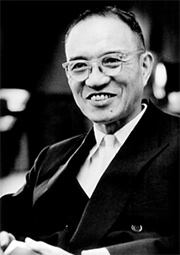
BridgestoneFounder Shojiro Ishibashi
![]()
Early History of Bridgestone Founder
At 17, Shojiro Ishibashi took over his family clothing business in Kurume, Fukuoka Prefecture in 1906. While heading up that business, he specialized in tabi (Japanese traditional socks), reformed the apprentice system, implemented a standardized pricing system, and created Jika-tabi (socks with rubber soles used as work shoes), developing a rubber shoe business with overseas production. But Shojiro's s dream was to contribute to the nation of Japan above and beyond the work of his family business. He believed in the future of motorized transportation in Japan, and he was adamant about producing tires domestically. Using the capital accumulated from Jika-tabi and the rubber shoe business, Shojiro decided to make tires, which was an industry that didn't exist in Japan at that time.
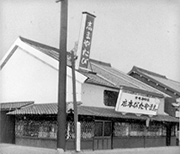 A home-made sign hangs over the |
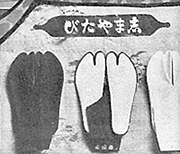 “Shimaya” tabi |
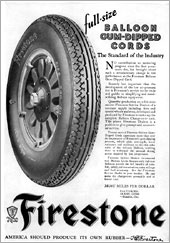
Bridgestone Firestone Collection
![]()
On Nov. 29, 1920, Ex-President William Howard Taft arrived in Akron and visited with Harvey S. Firestone; it was one of the first indicators that Firestone was becoming an important figure in national affairs. On April 5, 1922, factory production of the industry’s first low-pressure balloon tire began. This breakthrough was made possible by incorporating the gum-dipping process invented in early 1920, a method of insulating tire cords against internal heat. Balloon tires offered the average motorist extraordinary mileage for the time. On October 14, 1923, Harvey S. Firestone announced the completion of an agreement with the Liberian Government by which the Firestone Plantation Company obtained a 99-year lease of one million acres of land suitable for growing rubber. Back in America, Firestone began initiating the one-stop service store program, eventually called the Firestone Tire & Service Center.
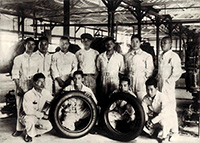
Tire builders with the first Bridgestone tires (size: 29x4.50 4PR) produced in April 9th, 1930
![]()
Creation of the Bridgestone Company and production of the first tire
At 17, Shojiro Ishibashi took over his family clothing business in Kurume, Fukuoka Prefecture in 1906. While heading up that business, he specialized in tabi (Japanese traditional socks), reformed the apprentice system, implemented a standardized pricing system, and created Jika-tabi (socks with rubber soles used as work shoes), developing a rubber shoe business with overseas production. But Shojiro's s dream was to contribute to the nation of Japan above and beyond the work of his family business. He believed in the future of motorized transportation in Japan, and he was adamant about producing tires domestically. Using the capital accumulated from Jika-tabi and the rubber shoe business, Shojiro decided to make tires, which was an industry that didn't exist in Japan at that time.
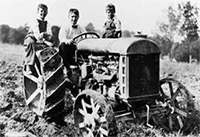
"Put the Farm on Rubber" campaign
![]()
In the United States, the Depression hit the automobile industry and along with it, the tire business. Firestone sales began a five-year decline. To expand its market, Firestone developed the first practical low-pressure pneumatic tractor tire and began the “Put the Farm on Rubber” campaign. Just a few years later, Firestone’s sales enjoyed a remarkable turnaround. Sales, which began to decline in 1930, ended up at $121 million in 1935. On Feb. 7, 1938, Harvey S. Firestone died in his sleep at his vacation home in Miami Beach.
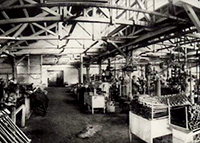
The Asahi plant (Saga Prefecture) moved its production from aircraft tires (wheel) to bicycles in the aftermath of the war, and this lead to the establishment of the Bridgestone Cycle Company.
![]()
Challenges brought on by World War II
Wartime regulations were in effect throughout Japan, which resulted in nearly all of the company's output being used to satisfy military demand. Although 1945 saw the end of armed conflict, the company had been directly impacted by the war and faced challenges in rebuilding their business operations.
The Bridgestone Tokyo Headquarters building was destroyed during an aerial bombing raid, and all of its overseas assets were lost. Fortunately, the plants in Kurume and Yokohama escaped unscathed, and the company was able to restart production immediately after the war ended. The company overcame many obstacles and eventually emerged from the war as a stronger organization.
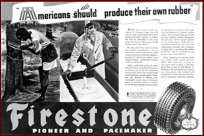
Heightened wartime research lead to the company’s first synthetic rubber. The need for synthetic rubber was intensified by the threat of war disrupting natural rubber shipments from Africa and Asia.
![]()
As war loomed in Europe and Asia, the possibility that natural rubber shipments from Africa and Asia would be cut off grew rapidly. To fill the need for a natural rubber substitute, Firestone started producing synthetic rubber. The company developed and began manufacturing special tires for combat vehicles and other military items, and by 1942, Firestone became the first to produce synthetic rubber in a government-owned plant. As the company turned 45, the company had made extraordinary contributions to the war effort, including synthetic rubber and a variety of products that could also be used in post-war times.
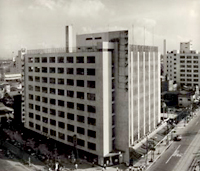
The completion of Bridgestone's headquarters in Kyobashi (current location), Tokyo (1951)
![]()
Technological innovation and mass production
In 1951, Bridgestone was the first company in Japan to begin selling rayon cord tires, and a five-year project to modernize production facilities was started. This year also saw another Bridgestone building opened in Kyobashi, Tokyo, which contained the Bridgestone Museum. Sales surpassed 10 billion yen in 1953, placing Bridgestone at the top of tire industry in Japan, and celebrations were held to commemorate the 25th anniversary of the company's establishment in Kurume in 1956. Bridgestone began selling nylon tires in 1959.
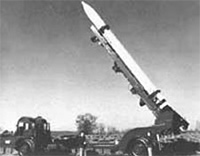
Corporal Guided Missile
At the time of the 50th anniversary, the war in Korea was underway and Firestone was very much a part of the war effort. In Fall River, Massachusetts, The Firestone Rubber & Tire Company made gas masks, and in Akron, Plant 3 was devoted to defense products—it was expanded to the point that Firestone was ranked as one of the principal producers of 57mm and 75mm recoilless rifles for ground forces. At the Los Angeles plant, Firestone began producing the Corporal guided missile for the government, and by 1953 Firestone’s defense business was at its peak with $1,029,492,035 in sales. On May 31, 1955, Firestone became the world’s largest rubber producer, producing at a rate of one million pounds of rubber per day. By 1959, the company had a total of 71 plants in 19 countries.
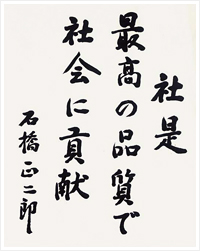
The company's motto written by the founder (established in 1968)
![]()
Radial tires and overseas expansion
For Bridgestone, the 60s was an era of overseas expansion that included the establishment of Bridgestone Tire Company of America in 1967 to serve as the company's U.S. sales headquarters. To better meet the needs of an expanding automotive market, a new plant opened in Tokyo in 1960. In 1961, Bridgestone was listed on the Japanese stock exchange, and adopted a new management structure with Shojiro Ishibashi as the chairman, and Kanichiro Ishibashi as the president. As part of the management transition, the company adopted the Deming Plan, which involves overall quality control activities. By 1968, Bridgestone earned the prestigious Deming Prize for excellence in quality management. Additions were built onto the Tokyo plant in 1962 to house the new Technical Center, and a progressive system of research and development was established. On the product front, 1967 saw the sale of its first passenger-vehicle radial tire, the RD-10. The company’s opened its first overseas plant since the end of WWII in Singapore in 1965. Production began in Thailand in 1969.
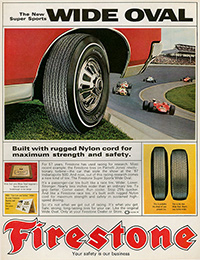
Super Sports Wide Oval tire
In September of 1960, Dun’s Review, a business magazine, picked Firestone as one of the 10 best managed companies in the nation. A year later, Firestone acquired Dayton Tire. From 1964-65, Firestone introduced and began producing radial ply passenger tires for replacement use on lightweight American and European cars, as well as the “Super Sports Wide Oval” tire. Called the “Shape of the Future,” the tire was readily accepted by auto manufacturers as original equipment on many 1967 high-performance cars. This concept of wide, low-profile tires for high-performance cars continued throughout the century. In August 1965, the company celebrated its 65th anniversary with the largest annual sales in its history- a record $1.45 billion was generated by employees in 23 countries. At that point, the company made and marketed 3,600 types and sizes of tires as well as 2,000 other products in the fields of rubber, metals, plastics, synthetics, textiles and chemicals. Firestone later also became one of the nation’s major seatbelt suppliers.
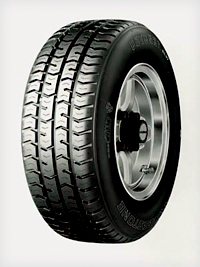
RE47, the first of the POTENZA high-performance radial tires (1979)
![]()
The completion of plants in Japan and expansion into Asia and Oceania
The oil shock of the early ‘70's brought about economic stagnation in Japan. Despite these challenges, during this period Bridgestone was placing even more emphasis on establishing its own technology for the manufacture of radial tires and was building new tire plants in Japan. Its Super Filler Radial was placed on the market in 1978, and in 1979, the company released the high-performance POTENZA radial tire. The company also actively continued to expand overseas. In addition to beginning production in Indonesia and Iran in 1976, the company invested in a Taiwanese tire manufacturer and purchased a tire plant. In 1980, Bridgestone purchased a plant for manufacturing tires and diversified products in Australia. During this period of growth and expansion, the Bridgestone family of companies also lost its founder— Shojiro Ishibashi died on Sept. 11, 1976.
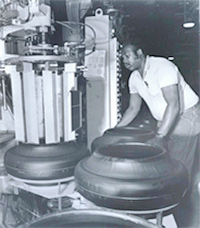
Firestone developed the first American-made, steel-belted radial tire.
Now ranked 37 in the top 50 American corporations, the diversification of the company had accelerated to areas ranging from coated fabrics to footwear. But the 1970s brought some significant setbacks for Firestone. On Oct. 17, 1973, Arab nations began an oil embargo against the United States in an attempt to raise prices and alter U.S. support of Israel. This began a series of consequences which impacted Firestone and other American tire makers for years to come—people started driving less and not as far, and the demand increased for smaller European and Japanese cars. In 1975, despite years of success, Firestone officially stepped out of motorsports. A few years later, in the biggest product recall in the nation’s history at the time, Firestone recalled 400,000 Firestone 500 steel-belted radial tires at a cost of $148.3 million.
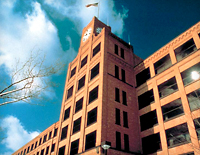
The Akron headquarters of the Firestone Tire & Rubber Company, which later became one of the three Technical Centers for Bridgestone Corporation in 1990
![]()
Bridgestone merges with the Firestone Tire & Rubber Company to become a global leader
On March 1, 1981, Bridgestone celebrated its 50th anniversary. The company set its sights on strengthening its homebase while simultaneously expanding overseas to hopefully become of the world's top three manufacturers of rubber products. As part of this strategy Bridgestone purchased a tire plant in Tennessee from the Firestone Tire & Rubber Company, which became the company's first manufacturing plant in North America. Bridgestone began production of truck and bus radial tires at the plant in 1983. In May 1988, Bridgestone acquired The Firestone Tire & Rubber Company, which transformed Bridgestone into one of the world's largest tire and rubber companies. The acquisition of Firestone gave Bridgestone a large number of production sites in North America, Central and South America, Europe, and other locations. Bridgestone also began operations in Turkey under a joint management agreement in 1988. To enhance the company's corporate identity, Bridgestone Tire Co.,
Ltd. was renamed to Bridgestone Corporation in 1984.
![]()
Global Expansion
The company's successful integration efforts with Firestone led to strong profits in 1992 and the establishment of a new European and American headquarters location for Bridgestone. To enhance the company's brand awareness and build on Firestone's heritage of motorsports excellence, in 1995, Bridgestone re-entered the Firestone brand into the Indianapolis 500 race and to IndyCar racing, one of America's most popular motorsports. The Bridgestone brand entered Formula 1 racing in 1997, which is the one of the most popular and technologically-advanced forms of racing worldwide. New production facilities were also established in Thailand, India, Poland, China, the United States and other countries as the company continued to expand its business globally.
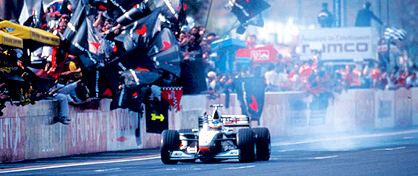
A Formula 1 team racing on Bridgestone tires wins the F1 in the company's second year in F1 racing (1998)
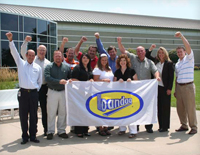
Member of Bridgestone Bandag, LLC Shot in front of Bandag learning center in Iowa, USA
![]()
A global company of excellence
In 2000, the Chemical and Industrial Products Technical Center was built inside the Yokohama Plant to serve as the technology and innovation hub for the company's growing Diversified Products business. In 2001, the Bridgestone global family of companies adopted a new corporate philosophy, which focused on building “Trust and Pride” with the company's key stakeholders, which included employees, customers and neighbors in the communities where Bridgestone facilities are located. In 2007, Bridgestone acquired Bandag, Incorporated, a tire retreader based in the United States. This allowed Bridgestone to provide truck and bus tire customers worldwide with leading technology and a total tire solution. Bridgestone remains committed to being a world leader in tire technology, developing technologically-advanced tires and rubber products, and always providing world-class customer service.

